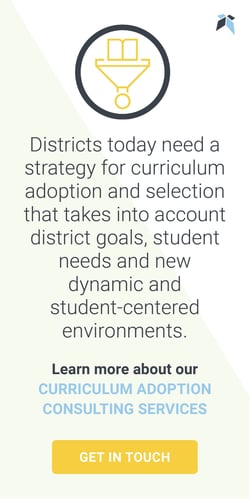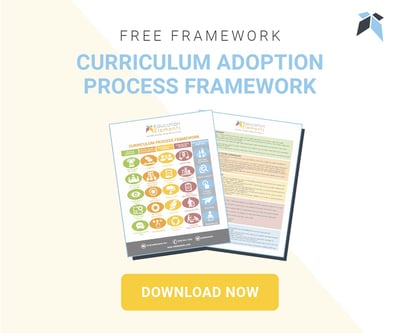
By: Lindsey Oh & Ray Rozycki on August 8th, 2017
What Exactly Is Curriculum?
Curriculum Strategy & Adoption | Classrooms
I recall one distinct shocking moment as a new teacher. It was when a mentor teacher was onboarding me. She walked me to my classroom, opened a cabinet door rather proudly, showed me two shelves filled with textbooks and supplementary materials (worksheets, assessment guides, etc.) and said, “This is your 6th grade math curriculum.”
 Flipping through the materials, I could not believe my eyes. The materials were barely different from when I was a student. They were still talking about agricultural stats from the 1960s in one of the word problems, and that agricultural stat was not particularly relevant to my students or to me. Perhaps what was most shocking to me was that this was all that my mentor teacher had provided. A bunch of worksheets made by a textbook publisher. Really? Is this how kids were to be taught in the 21st century? Did old textbooks equal their current curriculum?
Flipping through the materials, I could not believe my eyes. The materials were barely different from when I was a student. They were still talking about agricultural stats from the 1960s in one of the word problems, and that agricultural stat was not particularly relevant to my students or to me. Perhaps what was most shocking to me was that this was all that my mentor teacher had provided. A bunch of worksheets made by a textbook publisher. Really? Is this how kids were to be taught in the 21st century? Did old textbooks equal their current curriculum?
I ended up making my own materials -- video content, cross-curricular lessons, and others -- to aid in the “curriculum.” All the while focusing on this key question: “What skills do I need to equip them with for their success in 6th grade and higher, both in and outside their classroom life?”
Since then, I’ve developed a passion for the meaning of curriculum. Here is what I believe curriculum is and is not: Curriculum is not a textbook, nor the materials, videos and worksheets that help us instruct students. It is the knowledge and skills that students are expected to learn as they progress through our school system. The books my mentor teacher showed me should have been a piece of the puzzle, not the completed puzzle.
Download our Curriculum Adoption Process Framework
As instructional materials come of age and permit educators greater opportunities for personalization and more tools and approaches to present material to students, our focus on curriculum in schools needs to shift. My mentor teacher used static print materials and worksheets as her tools to deliver instruction and prepare her students for their next steps in life. With today’s technology and the accessibility of dynamic content, we need to be focusing our curriculum discussions (and decisions) less around static materials and the tools to present information. Rather, we should focus our energy towards conversations about identifying opportunities and connections that help our students build the skills, processes and habits which enable them to be productive contributors of the 21st century society.
Out of this fundamental belief about curriculum, we have developed the core pillars to anchor your thinking, as you look at revising what curriculum means in your school system. For each area, we have identified essential questions to answer:
- Policy & Oversight -- What is the vision, common understanding, roles and responsibilities of the personnel involved in the curriculum process?
- Written, Taught & Tested Curriculum -- What are the timelines, expectations and standards for what is to be written, taught and tested to ensure students’ knowledge and skills required in a certain subject area?
- Accessibility & Support -- Are proper rollout plans and support systems in place to ensure a successful curriculum change?
- Evaluation & Revision -- Are there plans to ensure success and fidelity of the new curriculum plan?
- Cyclic Resource Adoption -- Are the resources that aid in delivering the curriculum being properly and regularly updated and purchased as needed?
Stay tuned for our next post on how these pillars can help ensure a successful curriculum adoption for 21st century learning. In the meantime, I’d encourage you to have a conversation with your curriculum team about your current definition of curriculum, and what you believe the critical factors are for a successful curriculum adoption process. Share your thoughts with us via Twitter or email.
More Curriculum Adoption reading
Blog: The Core 4 Elements of Personalized Learning
Blog: Selecting Digital Content for Your School: A How-To Guide
Blog: Want to Build a Successful Curriculum Blueprint? Here's Our Recipe
Blog: Critical Questions to Ask When Building a Life-Changing Curriculum Process


/Image%20Curriculum%20Adoption%20Process%20Blog%20Series%201.png?width=525&name=Image%20Curriculum%20Adoption%20Process%20Blog%20Series%201.png)
